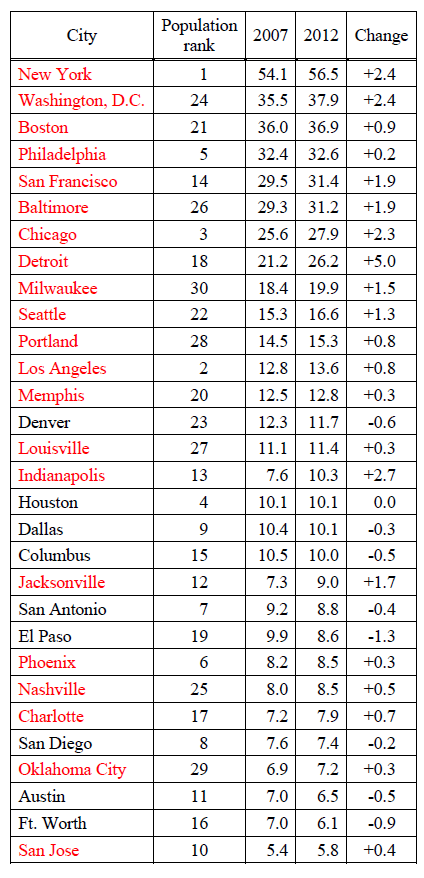Study Shows U.S. Households Without A Vehicle Increased In 21 Of 30 Largest Cities Since 2007

It’s difficult to tell just how much of the current trends in U.S.-based driving and car ownership are linked to the 18-month economic recession that began in December 2007, but according to a new report there are more U.S. households without cars in a majority of the country’s top 30 largest cities by population.
And we’re not just talking about New York or Boston, which have relatively strong public transportation infrastructures. Oklahoma City, for example, saw a slight uptick in households without a passenger car, SUV or light-duty truck, to 7.2 percent, while Milwaukee, the smallest city on the list by population, saw auto-less households increase by 1.5 percent to just under 20 percent, according to a report released Tuesday by the University of Michigan’s Transportation Research Institute (UMTRI), the third of a three-part study that asks the question: Has motorized transportation peaked in the U.S.?
“The combined evidence from these three studies indicates that—per person, per driver, and per household—we now have fewer light-duty vehicles, we drive each of them less, and we consume less fuel than in the past: The fuel-consumption rates now are lower than they were in 1984, the first year of this analysis,” concluded Michael Sivak, UMTRI’s director of sustainable transportation and the author of the report. This may seem peculiar in light of the current trend in the U.S. automotive market, which is seeing a robust rebound in new-auto sales from the 2009 statistical valley caused by the subprime mortgage meltdown. But the rebound is just that. The rosy forecasts we see for this year of sales topping 16 million are still about a million shy of the record 17.4 million units bought in 2000 despite significantly more car buyers today.
The onset of the trends identified by Sivak's study precede the start of the Great Recession. For example, the distances driven per person, per licensed driver and per household peaked in 2004 and began declining ahead of the economic downturn. Gasoline consumption per person, per driver and per household has also declined from a peak in 2004, albeit partly because newer cars are more fuel-efficient. The latest overall fuel economy rating for vehicles in the current model year stands at 24.8 miles per gallon based on new vehicles bought in December, according to research by Sivak and Brandon Schoettle. But the data suggest fuel economy isn’t the only factor; the decline in the distances driven also played a significant role.
Here’s the list of the top 30 cities and the percentage increases in households without cars since 2007:

About 51 million people live in these 30 cities, representing about 16 percent of the U.S. population, according to 2012 U.S. Census Bureau estimates. Out of the nine cities that saw household car ownership increase, seven are in Texas. The biggest increases in households without cars were seen in New York, which thanks to the densely populated NYC metropolitan zone has the nation’s highest number of households without a passenger vehicle (56.5 percent), and Washington, D.C. Both saw a 2.4 percent uptick.
--
(Note: San Diego Freeway in Los Angeles, Calif. photo by Shutterstock.com.)
© Copyright IBTimes 2024. All rights reserved.












